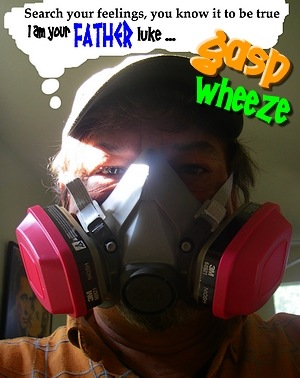
I figure it was some great sin in a past life – nothing newsworthy or famous, just some callous Lothario that fleeced spinsters of their birthright, some real estate wunderkind that unloaded worthless railroad right-of-way by foreclosing on widows and orphans.
Others have a knack for useful things like plumbing or electrical wiring, own a house full of beaming children and spend most of their time basking in the adoring gaze of their spouse.
Me, I wallow in toxins.
I smile as girlfriend backs out of the garage, giving “thumbs up” while waving the list of “honey-do’s” – and as soon as she’s upwind I’m adding a dab of this to a dollop of that, all of which have skulls and crossbones on the label.
… all of which say, “empty into your sink when finished.”
The sport may be “green” but its components are pure death.
With strong winds in the area and “Momma” elsewhere, it was time to explore polyester and the disperse dyes needed to give it lasting color. Synthetics can be made from thousands of polymers, many of the items we use can be derivatives of nylon, polyester, rayon, or even a component of a natural material like viscose, comprised of plant or wood fiber.
All we see is “shiny” or “sparkly” and rarely delve further than shelling out the money for a nickel bag.
The nice folks that make the raw Soft Crimp Angelina material had sent me the Holy Grail of their “doll hair” fiber, a material data sheet that outlined the temperatures the fiber melts at, the temp the fiber loses its iridescence, and similar data that would allow me to dye their product without torching too many Ben Franklin’s …
Many of you have asked about the material, which is unavailable anywhere except in tiny little packets labeled, “Ice Dub.” I use it in raw form in countless flies and dubbing blends, but have shied away from coloring it because polyester requires caustic chemicals and plenty of heat.
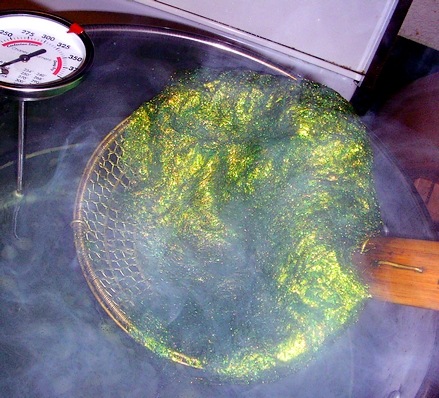 … not to mention the fumes, which is the Shit are pervasive and great odiferous. A well ventilated environment is needed so you can get the entire neighborhood lit and as kitchen cabinets, countertops, and flooring may be unknown material (may contain polyester) you can’t afford to drip the stuff on anything other than porcelain or stainless steel.
… not to mention the fumes, which is the Shit are pervasive and great odiferous. A well ventilated environment is needed so you can get the entire neighborhood lit and as kitchen cabinets, countertops, and flooring may be unknown material (may contain polyester) you can’t afford to drip the stuff on anything other than porcelain or stainless steel.
Skin is no problem. You could dip your head in it and brush your teeth, and after a couple whiffs you’ll want to …
Pro Chemical & Dye has dyes for every type of fiber you’ll encounter. With only 12 colors available for polyester you’ll need to learn the artist’s color wheel and how to construct complex colors from their components.
Example: Olive, a complex color made of equal parts yellow and green, with 1/2 a part of dark grey or black. Add yellow to make it a “warm” olive, and more green to make it a “cold” olive, and add more black to make it a dark olive (either warm or cold). For the below colors I used equal parts Kelly green and Buttercup yellow, and a half part of Cool Black (Pro Chemical & Dye colors). Using Buttercup versus the Bright Yellow means I’ll err on the side of a warm Olive.
As I’ve had experience in dyeing colors and building shades and tints using their components, my goal was to build a color that resembles a Peacock herl or eye. The iridescence was the easy part – it was built right into the Aurora Soft Crimp Angelina, which has motes of bronze, green, and gold.
Peacock is a double complex color as it would be described as green, olive, dark green, bright green, or bronze, depending on the location of the herl and the genetics of the bird itself.
You can’t dye material “peacock” – instead you dye three or four colors around it and blend them to make the final coloration. This is much easier than it sounds as dye baths will alter shades and color depending on the amount of time the material is left soaking.
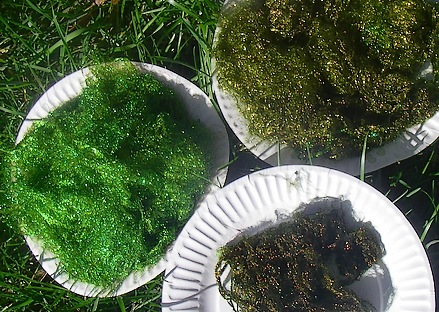
Here is the damp material after 3 minutes (left), 6 minutes (top), and 9 minutes (bottom). One dye bath to color all three shades, only immersion time differs.
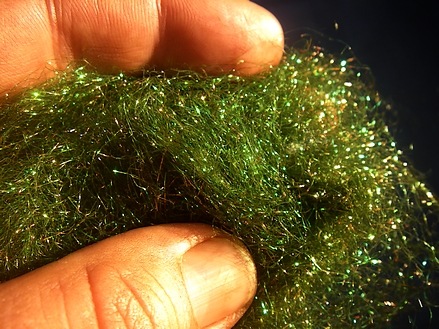
Here’s the final blended color seen under morning light. You can pick out the lighter tints and darkened fibers in the aggregate mass – and I still have the three other shades should I want to alter it further. I used the same formula when blending the result; one part green, one part darker olive, half a part of the darkest shade.
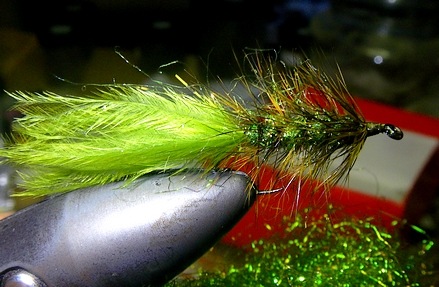
The above shows the mixture used on a traditional leech pattern, note how the florescent light makes the material much more green than the prior photo shot outdoors. Florescent is a “white” light – not blue tinted as is normal sunlight, it always lightens colors by one or more shades.
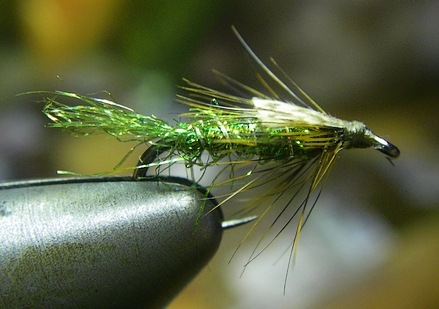
I always hated tying Zug Bugs as the peacock has difficulty hiding the bulge of lead wire underneath – plus its fragility. Above is a #14 Zug Bug tied with the blended color, note how the slip of mallard lies flat on the back (as it should). The finer filament coupled with the ability to build the proper taper with dubbing gives much more control over the fly than wound herl, and the durability is increased at the same time.
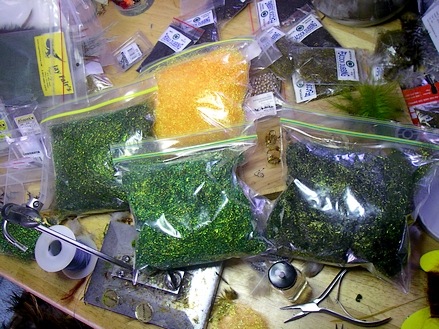
I still need a great deal more practice with these new dyes but once I’ve built the formula for colors and immersion times, I’ll be able to reproduce these with reasonable surety. Returning the material to its dry and fluffy state is also quite problematic as I’m still un-matting the fibers by hand.
Knowing my “stay of execution” is limited – I’m hustling the dye pot outside as soon as each color is achieved, there to cool down while fumes exit the house. The ceramic disk attached to the storm drain stares at me accusingly – a large fish with the entreaty, “this empties directly into the river.”
I considered the crime briefly, but opted for the squirrel burrow in the backyard. While the label says it’s safe I’d rather be entertained by a florescent Orange squirrel staggering out of his burrow on unsteady legs.
The kids next door trundle up to investigate and I’m unaware until the little blond angel wrinkles her nose and says, “oOo, what’s that smell?”
They’re peering into the algae colored water with the shiny bits of debris – and I’m croaking out my best sinister through the rebreather, “ .. in the cauldron boil and bake, eye of newt and toe of frog, wool of bat and tongue of your dog …”
… they screamed appreciatively all the way back to the house. Ma came out to make sure all was well – and fixed me with the obligatory “you are so bad” look as soon as chubby fingers pointed in my direction.
It means visitors next Saturday night requiring a double fistful of Snickers to pay for my sins.
Tags: Peacock, Ice Dub, Soft Crimp Angelina, Pro Chemical & Dye, polyester, disperse dyes, Halloween, little blond angel, toxic chemicals, Leech, Zug Bug, fly tying materials, fly tying

Great stuff……I would have thought you’d have added some royal blue or purple, too. As far as the fumes, you live in Calif., don’t you? 😉
I know, I should’nt talk living here in toxic jersey…………breath deep, the gathering gloom…..
Matt G
Is that a Xeron?
Beautiful looking blend IMO.
Yessir, it’s a Catskill, Thomas, Phelps, a.k.a. Xuron vise. I’d be hard pressed to say a better vise exists. This one has had about 600,000 trout flies run through its jaws, with nary a blemish.
This one was purchased about 1980 when it was the Phelps vise, it bacame the “Xuron” shortly afterward.
They’re still made – considering its $165 for the top of the line with pedestal it’s even cheap by today’s standards.
http://www.stsimonsoutfitters.com/Xuron-Vise-History_ep_40-1.html
solid. how does this ungrateful bastard get his hands on some?
By guilting me into a fistful ’cause he asked … like normal. I’ll see if I can get to the Post Office tomorrow.
Did you find a bulk source for the Angelina that you would be willing to share or would be be willing to sell some of it? I am intersting in trying this myself. I am sure that as soon as my wife smells the stench I will have to out the project on hold. 🙂
Thanks
Roy
Roy,
Meadowbrook Glitter is who makes the Angelina fiber, but the minimum order is 10 lbs. I bought some with the intent of dyeing it up and repackaging it – as no vendor has materialized to offer this material in any other form.
I’m not thinking of postage stamp amounts, more fractions of ounces or larger – so that a tyer can score enough at one time to make it worthwhile.
Ice Dub is ~$4 per package. I was hoping I could make 1/4 ounce about the same price. That’s probably about 4-5 packages of the regular stuff – making it about 1/4 the price of retail.
My labor is the asterisk in all this. Dyes cost money as does shipping and packaging, but the bulk of the expense is my time. That and standing in line at the Post Office …
I’m working on streamlining the process to make it economically prudent.
In the meantime send me your address via email, and I’ll send you some samples to fiddle with … that’ll give you something to look at and test.
My email address is on the “about” page at the top of the screen.
The website and additional information on Angelina is contained in prior posts. Run a search for “Angelina” in the search box at the top of this page. You’ll find the links to the vendor website in those articles.
Man this stuff is amazing. What do they charge for 10 pounds?
It varies based on color, length, and a couple other variables – assume $500 and up.
Nice stuff, How did your peacock turn out. Have you incorporated any other colors into the peacock. Like, reds, blues and purples.
Just curious. I use a ton of Siman Peacock from the Czech Republic and mix my own peacock mixes with FT Dungeons Peacock, but always keeping an eye out for more peacock mixes in various colors.
Chad – yes, I have been adding some forest green fur into the mix to match the exact Siman blend – and have added a bewildering mix of test colors in “mad Doctor” mode.
… a little of this added to a dab of that, type experimentation.
I’ve got an exact match to Siman’s variant, and am attempting his two other peacock colors; bronze peacock and Peacock eye.
This weekend I’ll be working on browns. Dark, medium, golden, and rust. They’ll be used in my stonefly nymphs mostly.
The difficulty is coming up with the proper dye formula. A “Rust” brown is a reddish brown, and you have to translate that to the primary color wheel components; red, cyan, and yellow.
Orange and Purple make a brown. That translates into 1 Red 1 Yellow +1 Red +1 Cyan.
= 2 Red 1 Yellow 1 Cyan + an unknown amount of Red to make it “reddish” brown. It’s very slow going as a lot of experimentation is needed to build the right color.
Kevin,
I would love to see some of your peacock dubbings. An exact match, very impressive.